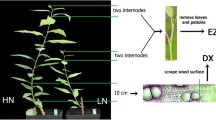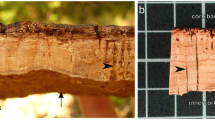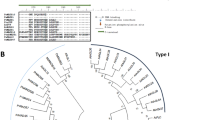Abstract
Loss of verticality in conifers affects the normal wood development by inducing changes and chemical modifications in tree stems called compression wood. It is known that ethylene influences the response during this abnormal wood-forming process. The expression pattern of genes involved in the ethylene biosynthesis pathway during gravitropic response in gymnosperms has been identified in adult trees. Young seedlings of radiata pine were inclined to reveal the expression pattern of these genes by the quantitative real-time PCR (qRT-PCR) technique. The seedlings were exposed to gravitropic stimuli and harvested after 2.5 and 10 h (early responses) of inclination, and after 24 h (late response). Sampling includes transverse cuts at three heights of the whole stem of inclined seedlings. Our data revealed that genes encoding for 1-aminocyclopropane-1-carboxylate oxidase (ACO) and 1-aminocyclopropane-1-carboxylate synthase (ACS) were differentially expressed during the time of leaning, and, interestingly, at the basal portion of radiata pine stems. Additionally, transcriptional analysis in maritime pine showed a conserved profile of gene activation in conifers, and in mature compression wood, ACO gene transcription was strongly upregulated. These results indicate that the concerted activation of genes involved in ethylene biosynthesis could be responding to leaning signals in young radiata and maritime pine seedlings.





Similar content being viewed by others
References
Andersson-Gunnerås S, Hellgren JM, Björklund S, Regan S, Moritz T, Sundberg B (2003) Asymmetric expression of a poplar ACC oxidase controls ethylene production during gravitational induction of tension wood. Plant J 34:339–349
Barker JE (1979) Growth and wood properties of Pinus radiata in relation to applied ethylene. N Z J For Sci 9:15–19
Barnes JR, Lorenz WW, Dean JFD (2008) Characterization of a 1-aminocyclopropane-1-carboxylate synthase gene from loblolly pine (Pinus taeda L.). Gene 413:18–31
Bleecker AB, Kende H (2000) Ethylene: a gaseous signal molecule in plants. Annu Rev Cell Dev Biol 16:1–18
Clark DG, Richards C, Hilioti Z, Lind-Iversen S, Brown K (1997) Effect of pollination on accumulation of ACC synthase and ACC oxidase transcripts, ethylene production and flower petal abscission in geranium (Pelargonium × hortorum L.H. Bailey). Plant Mol Biol 34:855–865
Clifford PE, Oxlade EL (1989) Ethylene production, georesponse, and extension growth in dandelion peduncles. Can J Bot 67:1927–1929
Clifford PE, Reid DM, Pharis RP (1983) Endogenous ethylene does not initiate but may modify geobending: a role for ethylene autotropism. Plant Cell Environ 6:433–436
Dolan L (1997) The role of ethylene in the development of plant form. J Exp Bot 48:201–210
Du S, Yamamoto F (2007) An overview of the biology of reaction wood formation. J Integr Plant Biol 49:131–143
Eklund L, Tiltu A (1999) Cambial activity in normal spruce Picea abies Karst (L.) and snake spruce Picea abies (L.) Karst f. virgata (Jacq.) Rehd in response to ethylene. J Exp Bot 50:1489–1493
Fukaki H, Tasaka M (1999) Gravity perception, gravitropic response of inflorescence stems in Arabidopsis thaliana. Adv Space Res 24:763–770
Harrison MA, Pickard BG (1986) Evaluation of ethylene as a mediator of gravitropism by tomato hypocotyls. Plant Physiol 80:592–595
Haswell ES (2003) Gravity perception: how plants stand up for themselves. Curr Biol 13:761–763
Herrera R, Krier C, Lalanne C, Stokes A, Salin F, Plomion C (2010) (Not) Keeping the stem straight: insights from phenotypic and proteomic analysis of young maritime pine seedlings. BMC Plant Biol 10:217–228
Higuchi R, Fockler C, Dollinger G, Watson R (1993) Kinetic PCR analysis—real-time monitoring of DNA amplification reactions. Biotechnology (NY) 11:1026–1030
Johnson PR, Ecker JR (1998) The ethylene gas signal transduction pathway: a molecular perspective. Annu Rev Genet 32:227–254
Kang BG, Burg SP (1974) Ethylene action on lateral auxin transport in tropic responses, leaf epinasty, and horizontal mutation. In: Kaigi NG (ed) Plant growth substances. Hirokowa Publishing, Tokyo, pp 1090–1094
Kaufman P, Pharis RP, Reid DM, Beall FD (1985) Investigations into the possible regulation of negative gravitropic curvature in intact Avena sativa plants and in isolated stem segments by ethylene and gibberellins. Physiol Plant 65:237–244
Kende H (1993) Ethylene biosynthesis. Annu Rev Plant Physiol Plant Mol Biol 44:283–307
Klintborg A, Eklund L, Little CH (2002) Ethylene metabolism in Scots pine (Pinus sylvestris) shoots during the year. Tree Physiol 22:59–66
Le Provost G, Paiva J, Pot D, Brach J, Plomion C (2003) Seasonal variation in transcript accumulation in wood-forming tissues of maritime pine (Pinus pinaster Ait.) with emphasis on a cell wall glycine-rich protein. Planta 217:820–830
Le Provost G, Herrera R, Paiva J, Chaumeil P, Salin F, Plomion C (2007) A micromethod for high throughput RNA extraction in forest trees. Biol Res 40:291–297
Leopold AC, Brown KM, Emerson FH (1972) Ethylene in the wood of stressed trees. HortScience 7:175
Lewis DR, Ramirez MV, Miller ND, Vallabhaneni P, Ray WK, Helm RF, Winkel BS, Muday GK (2011) Auxin and ethylene induce flavonol accumulation through distinct transcriptional networks. Plant Physiol 156:144–164
Liang XW, Abel S, Keller JA, Shen NF, Theologis A (1992) The 1-aminocyclopropane-1-carboxylate synthase gene family of Arabidopsis thaliana. Proc Natl Acad Sci USA 89:11046–11050
Little CHA, Eklund L (1999) Ethylene in relation to compression formation in Abies balsamea shoots. Trees 13:173–177
Little CHA, Pharis RP (1995) Hormonal control of radial and longitudinal growth in the tree stem. In: Gartner BL (ed) Plant stems: physiology and functional morphology. Academic Press, San Diego, pp 281–319
Little CHA, Savidge RA (1987) The role of plant growth regulators in forest tree cambial growth. Plant Growth Regul 6:137–169
Love J, Björklund S, Vahala J, Hertzberg M, Kangasjärvi J, Sundberg B (2009) Ethylene is an endogenous stimulator of cell division in the cambial meristem of Populus. Proc Natl Acad Sci USA 106(14):5984–5989
Nie X, Singh RP, Tai GC (2002) Molecular characterization and expression analysis of 1-aminocyclopropane-1-carboxylate oxidase homologs from potato under abiotic and biotic stresses. Genome 45:905–913
Park KY, Drory A, Woodson WR (1992) Molecular-cloning of an 1-aminocyclopropane-1-carboxylate synthase from senescing carnation flower petals. Plant Mol Biol 18:377–386
Philosoph-Hadas S, Meir S, Rosenberger I, Halevy AH (1996) Regulation of the gravitropic response and ethylene biosynthesis in gravistimulated snapdragon spikes by calcium chelators and ethylene inhibitors. Plant Physiol 110:301–310
Plomion C, Pionneau C, Brach J, Costa P, Baillères H (2000) Compression wood-responsive proteins in developing xylem of maritime pine (Pinus pinaster ait.). Plant Physiol 123:959–969
Savidge RA, Mutumba GMC, Heald JK, Wareing JK (1983) Gas chromatography–mass spectroscopy identification of 1-aminocyclopropane-1-carboxylic acid in compression wood vascular cambium of Pinus contorta Dougl. Plant Physiol 71:434–436
Scurfield G (1973) Reaction wood: its structure and function. Science 179:647–655
Sundberg B, Tuominen H, Little C (1994) Effects of the indole-3-acetic acid (IAA) transport inhibitors N-1-naphthylphthalamic acid and morphactin on endogenous IAA dynamics in relation to compression wood formation in 1-year-old Pinus sylvestris (L.) shoots. Plant Physiol 106:469–476
Tang X, Wang H, Brandt AS, Woodson WR (1993) Organization and structure of the 1-aminocyclopropane-1-carboxylic acid oxidase gene family from Petunia hybrida. Plant Mol Biol 23:1151–1164
Timell TE (1986) Compression wood in gymnosperms, Vol 2. Heidelberg, Springer-Verlag, pp 983–1262
Vandesompele J, De Preter K, Pattyn F, Poppe B, Van Roy N, De Paepe A, Speleman F (2002) Accurate normalization of realtime quantitative RT-PCR data by geometric averaging of multiple internal control genes. Genome Biol 3:1–11
Wang KLC, Li H, Ecker JR (2002) Ethylene biosynthesis and signaling networks. Plant Cell 14:131–151
Went FW (1974) Reflections and speculations. Annu Rev Plant Physiol 25:1–26
Wheeler RM, Salisbury FB (1980) Gravitropism in plant items may require ethylene. Science 209:1126–1127
Wheeler RM, Salisbury FB (1981) Gravitropism in higher plant shoots. Plant Physiol 67:686–690
Wilson BF, Archer RR (1977) Reaction wood: induction and mechanical action. Annu Rev Plant Physiol 28:23–43
Woltering EJ (1991) Regulation of ethylene biosynthesis in gravistimulated Kniphofia (hybrid) flower stalks. Plant Physiol 138:443–449
Yang SF, Hoffman NE (1984) Ethylene biosynthesis and its regulation in higher plants. Annu Rev Plant Physiol 35:155–189
Yuan S, Dean JF (2010) Differential responses of the promoters from nearly identical paralogs of loblolly pine (Pinus taeda L.) ACC oxidase to biotic and abiotic stresses in transgenic Arabidopsis thaliana. Planta 232:873–886
Yuan S, Wang Y, Dean JF (2010) ACC oxidase genes expressed in the wood-forming tissues of loblolly pine (Pinus taeda L.) include a pair of nearly identical paralogs (NIPs). Gene 453:24–36
Zhang Z, Barlow JN, Baldwin JE, Schofield CJ (1997) Metal-catalyzed oxidation and mutagenesis studies on the iron (II) binding site of 1-aminocyclopropane-1-carboxylate oxidase. Biochemistry 16:15999–16007
Acknowledgements
This project was supported by FONDECYT (1071026), DIAT (Universidad de Talca), PBCT Anillo (ACT-41), Ecos-Conicyt (CB07-01), and postdoctoral PBCT-PSD61 projects. PR and CV thank Conicyt and Universidad de Talca, respectively, for Doctoral fellowships.
Author information
Authors and Affiliations
Corresponding author
Electronic supplementary material
Below is the link to the electronic supplementary material.
344_2011_9248_MOESM2_ESM.tif
Supplementary Figure 1. Amino acid alignment analysis of radiate pine ACO contigs. ACC oxidases obtained from P. radiata were aligned with ACC oxidases from other plant species, showing that they shared conserved motifs important for their catalytic function. Regions of high similarity are in black and the conserved residues involved in Fe2+ binding (two histidines, aspartate, arginine and serine) are indicated by asterisks (*). Additionally, black dots indicate the conserved amino acids necessary to coordinate Fe and ascorbate present in all ACC oxidases. Sequences were aligned using Bioedit Sequence Alignment Editor v7.0. Sequences correspond to GenBank accession numbers: PtACO1 (P. taeda, ADD65762), PpACO (P. pinaster, CBL95267), PttACO1 (P. tremula x P. Tremuloides, AAN87846), AtACO1 (A. thaliana, NP179549), SlACO1 (S. lycopersicum, P05116), NtACO1 (N. tabacum, CAA67119), MdACO1 (Malus x domestica, CAA67216) and Pglauca (P. glauca, AAA85365). (TIFF 1999 kb)
Rights and permissions
About this article
Cite this article
Ramos, P., Valenzuela, C., le Provost, G. et al. ACC Oxidase and ACC Synthase Expression Profiles after Leaning of Young Radiata (P. radiata D. Don) and Maritime Pine (P. pinaster Ait.) Seedlings. J Plant Growth Regul 31, 382–391 (2012). https://doi.org/10.1007/s00344-011-9248-2
Received:
Accepted:
Published:
Issue Date:
DOI: https://doi.org/10.1007/s00344-011-9248-2




